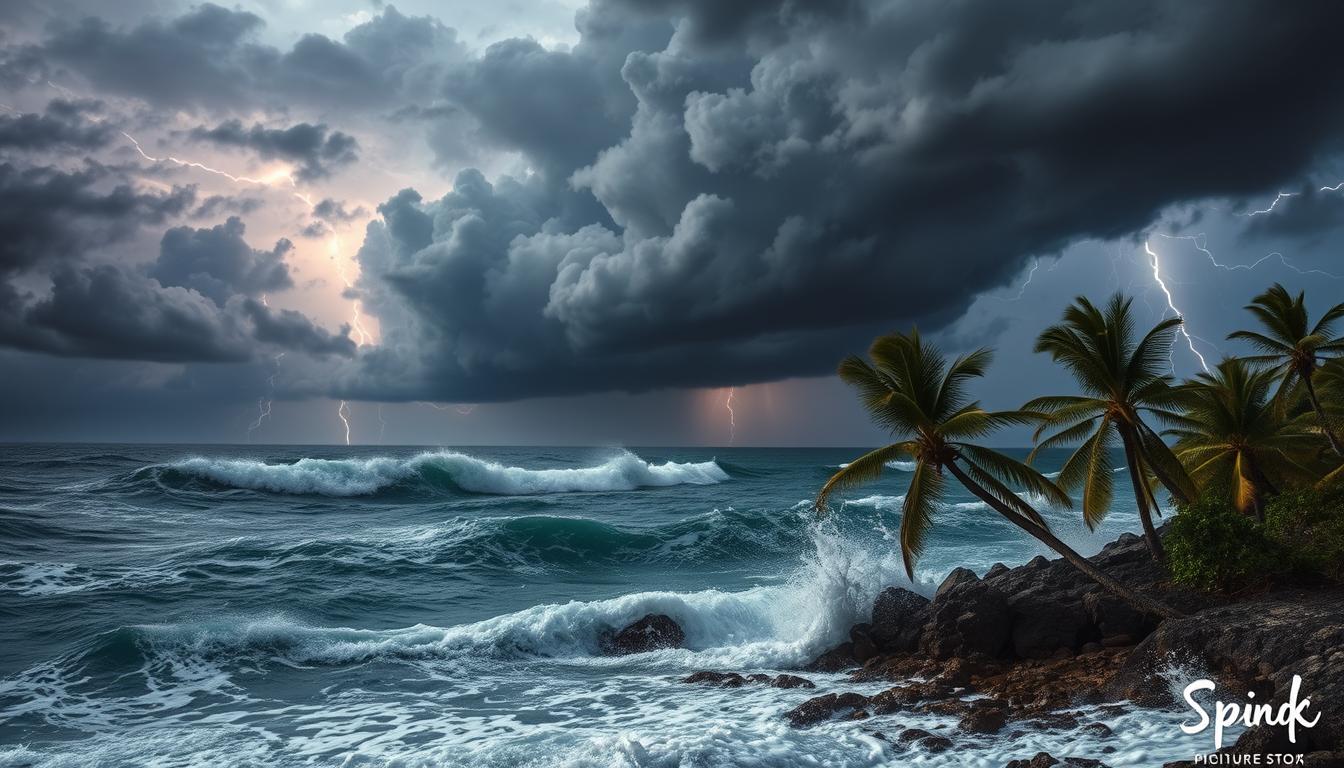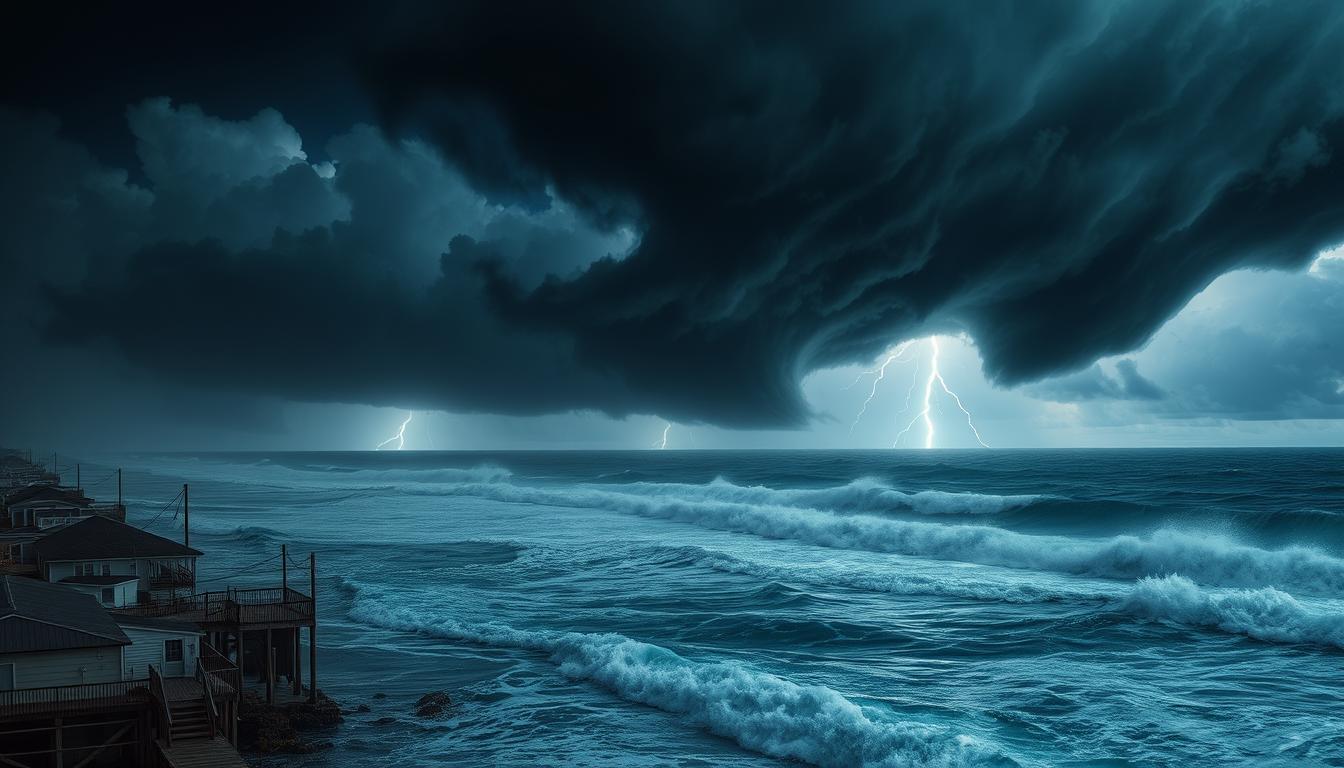The Atlantic hurricane season is getting more intense, with Hurricane Helene’s path and strength changing fast. How can you stay safe from this powerful storm? Let’s explore the latest updates and key insights to help you through this.
Key Takeaways
- Hurricane Helene is expected to hit Florida’s northwestern coast as a major hurricane (Category 3 or higher) with winds between 111 and 129 mph1.
- Storm surges of up to 20 feet are forecasted, especially in Florida’s Apalachee Bay1.
- Tropical storm-force winds and dangerous flooding are expected to hit a wide area, from Florida to the Carolinas2.
- Residents should watch the storm’s path closely and follow all evacuation orders from local authorities2.
- Stay informed with real-time hurricane tracker updates to make informed decisions and stay safe.
As the hurricane season gets more intense, we must stay alert and ready. By following the latest updates, we can make smart choices and protect our families and communities. Remember, staying informed is crucial to navigating through the storm.
What is Hurricane Helene?
Hurricane Helene is getting stronger as it moves over the warm waters of the Gulf of Mexico. It’s expected to quickly get even stronger, possibly reaching Category 4 strength before hitting Florida’s Big Bend region on Thursday night3.
By early Thursday, Helene was already a Category 1 hurricane with winds of 100 mph. Forecasters believe it will get even stronger, reaching major hurricane status (Category 3 or higher) with winds between 111 and 129 mph before landfall2.
Hurricane Helene’s Path and Intensity
The path and strength of Hurricane Helene are being watched closely. This is because they can greatly affect the areas they hit. Helene is now 320 miles southwest of Tampa, moving north-northeast at 12 mph2. It’s expected to bring tropical storm-force winds to South Florida, with gusts possibly over 55 mph2.
Coastal areas in Florida’s Big Bend and Panhandle could see a storm surge of up to 20 feet above ground level. Some parts of the Panhandle might see surges between 15 to 20 feet2. There’s also a 10 to 15% chance of sustained tropical-storm-force winds from West Palm Beach to Miami2.
As Hurricane Helene gets closer, many counties are taking action. Schools, universities, and government offices are closing due to the threat2. Experts say Helene’s wind field will be among the largest to hit the southeast U.S. since 19882.
With the potential for big impacts, it’s key for those in the affected areas to stay informed and ready for Hurricane Helene32.
Tracking Hurricane Helene
As Hurricane Helene gets closer to the United States, we’re watching it closely. The latest news says Helene is about 350 miles southwest of Tampa. It has winds of 90 mph and is moving north northeast at 12 mph1. Experts think it could become a Category 3 or higher hurricane, with winds over 110 mph1.
The National Oceanic and Atmospheric Administration (NOAA) is tracking Helene. They expect an above-average Atlantic hurricane season because of warm ocean temperatures1. The National Weather Service office in Tallahassee is also giving updates on the storm’s possible effects.
A live hurricane tracker shows Helene’s current spot and path. It looks like the storm will land with winds of 100 mph2. Only three Gulf hurricanes since 1988 were bigger than Helene’s predicted size: Irma in 2017, Wilma in 2005, and Opal in 19952.
People in the affected areas should keep up with the updates on Helene. Knowing the latest news can help families and communities get ready for the storm.
Potential Impacts of Hurricane Helene
Wind, Rain, and Flooding Threats
Hurricane Helene is heading towards the southeastern United States, causing worry. It’s forecasted to hit as a major hurricane, with winds between 111 and 129 mph1. The storm surge could be up to 20 feet in Florida’s Apalachee Bay, posing a huge risk, as warned by the National Weather Service1.
Helene will also bring heavy rain, with 4-8 inches expected in Florida and Georgia. This could cause a lot of flooding, making the storm’s effects worse3.
The National Hurricane Center has issued warnings for Florida’s west coast and parts of Georgia and North Carolina2. People in these areas should take evacuation orders seriously and prepare for the storm2.
| Hurricane Helene’s Impacts | Projected Severity |
|---|---|
| Wind Damage | Catastrophic, with sustained winds of 111-129 mph1 |
| Storm Surge | Catastrophic and unsurvivable, up to 20 feet in Apalachee Bay1 |
| Flooding | Significant, with 4-8 inches of rain expected across the Florida Panhandle and Georgia3 |
“Hurricane Helene could be the worst strike on a major Southern inland city in 35 years,” noted Georgia meteorology professor Marshall Shepherd2.
As Hurricane Helene gets closer to the southeastern US, everyone needs to be careful. The storm’s strong winds, storm surge, and heavy rain are a big threat. Quick action is key to protect lives and property.
Hurricane Tracker Updates
As Hurricane Helene gets stronger, it’s key to keep up with the latest news1. It’s expected to grow into a major hurricane, possibly reaching Category 3 or higher. This means winds could hit between 111 and 129 mph when it lands on Florida’s northwestern coast1.
Predictions show a storm surge of up to 20 feet in Florida’s Apalachee Bay. This could be “catastrophic and unsurvivable.”1
3Rapid intensification means a storm’s wind speed jumps by 30 knots (35 miles per hour) in 24 hours. Helene is set to hit the Big Bend area of Florida as a strong category 3 hurricane. Wind gusts could reach near 115 mph3.
The storm surge from Helene is expected to be “catastrophic” and potentially “unsurvivable” when it hits between Apalachicola and Cross City3.
4Hurricane Helene is forecasted to land along Florida’s Gulf Coast as a Category 4 storm. The storm could bring a storm surge as high as 20 feet in some areas4. The governors of Florida, Georgia, South Carolina, and North Carolina have declared states of emergency. Multiple counties in Florida have issued mandatory evacuation orders4.
| Metric | Value |
|---|---|
| Maximum Sustained Winds | 90 mph3 |
| Storm Speed | NNE at 12 mph3 |
| Potential Storm Surge | Up to 20 feet14, |
| Landfall Forecast | Category 3-4 hurricane34, |
Keep an eye out for updates on Hurricane Helene’s path and strength as it approaches the Gulf Coast. By staying informed with real-time information and weather alerts, we can better prepare and respond to this potentially devastating storm.
Preparing for Hurricane Helene
As Hurricane Helene gets closer to the Gulf Coast, states like Florida, Georgia, and the Carolinas are getting ready5. Their governors have declared emergencies, and some counties in Florida have ordered everyone to leave5. Schools and universities have also closed early because of the storm5.
Emergency Preparedness and Evacuation
Local leaders are telling people to leave their homes and find safer places5. But, not everyone can move because of lack of resources or means5. Still, officials stress the need for being ready for hurricanes to save lives.
The National Hurricane Center says Hurricane Helene will likely become a Category 3 storm before it hits, with winds up to 115 mph3. People in danger zones are advised to seek shelter and follow evacuation orders for their safety.
- Secure your home by boarding up windows, cleaning gutters, and trimming trees and shrubs5.
- Assemble an emergency kit with supplies like water, non-perishable food, batteries, and first-aid items5.
- Stay informed by monitoring local news and weather reports for the latest updates on Helene’s path and potential impacts5.
- Heed all evacuation orders and follow the instructions of local authorities5.
By taking these steps, people in Hurricane Helene’s path can better protect themselves5. Being prepared and alert is crucial when facing a powerful storm.
“Preparation is the key to survival when a hurricane is on the way. Heed the warnings, follow the evacuation orders, and take action to protect your family and your home.” – Governor Ron DeSantis, State of Florida
| Preparedness Measure | Description |
|---|---|
| Secure Your Home | Board up windows, clean gutters, and trim trees and shrubs to mitigate damage from high winds and flying debris. |
| Assemble an Emergency Kit | Stock up on essential supplies like water, non-perishable food, batteries, and first-aid items. |
| Stay Informed | Monitor local news and weather reports to stay up-to-date on Hurricane Helene’s path and potential impacts. |
| Heed Evacuation Orders | Follow the instructions of local authorities and evacuate your home if ordered to do so. |
Role of Meteorological Data Analysis
As Hurricane Helene approaches, the importance of meteorological data analysis in weather forecasting and emergency preparedness is huge. The National Weather Service office in Tallahassee has been closely analyzing meteorological data. They provide detailed forecasts and warnings about Helene’s potential impacts.
The hurricane center’s swells and wind forecasts help predict Helene’s effects on parts of Bermuda and the Azores. This data-driven decision making is key for emergency preparedness and response efforts, as shown in the latest reports.
Accurate hurricane modeling and weather forecasting based on detailed meteorological data help authorities and residents make informed decisions. They can take the right actions to reduce risks.
By using the latest in weather forecasting and hurricane modeling, we can better prepare for and respond to Hurricane Helene. This helps protect lives and lessen the impact on communities in its path.
Lessons from Past Hurricanes
As we face Hurricane Helene, it’s important to learn from past storms. The history of hurricane recovery and resilience teaches us valuable lessons. These lessons help us improve our emergency plans and prepare for the future1.
One key lesson is the need for early preparation. This year, the Atlantic hurricane season is expected to be busier than usual. This is because of warmer ocean temperatures1. Knowing the severity of hurricanes helps us take steps to protect our communities.
Another important lesson is how fast and unpredictable hurricanes can be. Tornadoes, for example, can quickly form and move, posing a big threat6. Having strong emergency communication systems and quick access to reliable info helps us respond better.
- Make a family emergency plan with a meeting spot and safe shelter to protect your loved ones6.
- Keep up with local news, NOAA Weather Radio, or community warning systems during hurricane season6.
- Work with local authorities and emergency agencies to make your community stronger and more resilient1.
By learning from past hurricanes, we can become more resilient. This helps us protect lives and property from future storms1.
“Resilience is not about bouncing back, but about bouncing forward. It’s about adapting, evolving, and becoming stronger in the face of adversity.”
| Lesson | Importance |
|---|---|
| Proactive Preparedness | Understanding potential hurricane severity to mitigate risks and protect communities. |
| Rapid and Unpredictable Weather Events | Developing robust emergency communication systems and access to reliable information. |
| Community Resilience and Disaster Recovery | Collaborating with local authorities and emergency management agencies to strengthen community resilience. |
By using the lessons of the past, we can make our society more resilient. We can face future hurricanes with confidence and determination1.
Importance of Hurricane Preparedness
As Hurricane Helene gets closer, it’s crucial to prepare. People must follow evacuation orders and take this seriously. The National Weather Service warns of a “catastrophic and unsurvivable” storm surge7. Evacuation is key to protect lives from a major hurricane8.
Emergency plans are vital to lessen the storm’s impact. Federal help is available for disaster response efforts9. FEMA offers funding for evacuation and shelter support in affected areas7.
Mitigating Risks and Protecting Lives
Residents must act now to protect themselves and their homes. Governor Ron DeSantis has listed many Florida counties under emergency7. The National Weather Service has issued a tornado watch for Florida counties7.
Charlotte County has declared a local emergency and opened shelters7. Evacuations are ordered for barrier islands and low-lying areas7. The county is also clearing grates and removing debris7.
Storm tides can reach up to 20 feet, causing massive damage8. Major hurricanes can have winds over 129 MPH, leading to catastrophic damage8. Shelters in Charlotte County are open, including ones for pets7.
By following evacuation orders and securing important documents, residents can stay safe. Preparing for Hurricane Helene is crucial for community safety9. It’s the best way to protect everyone789.,,
Conclusion
Hurricane Helene is getting stronger and heading towards the Florida Gulf Coast. It’s very important to watch the storm closely10. The hurricane could hit as a Category 4, with winds up to 130 mph11.
This storm could cause serious damage, including flooding and power outages. We must listen to the warnings from experts and emergency teams.
Communities in the Southeast are getting ready, with evacuations and school closures11. These steps are key to keeping people safe. By staying informed and prepared, we can protect our families and communities.
The hurricane season teaches us the value of being ready for emergencies10. Keeping up with updates and using weather tech helps us face storms better. Together, we can get through this season stronger and more ready for the future.
















Leave a Reply